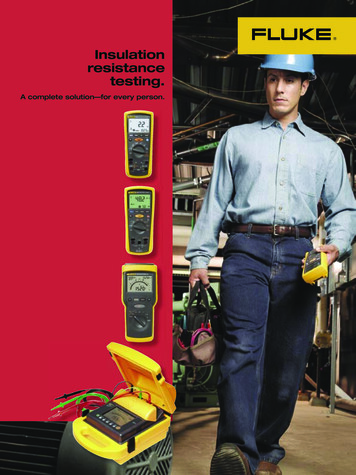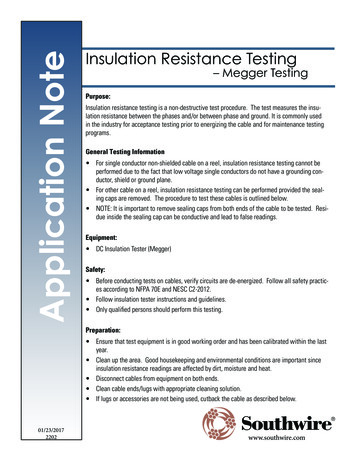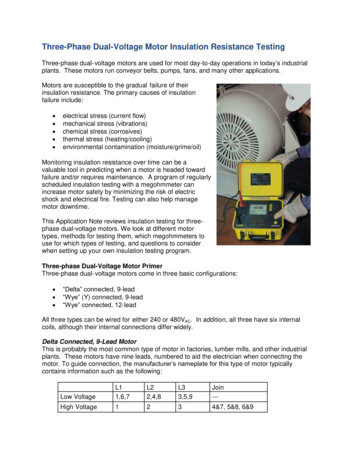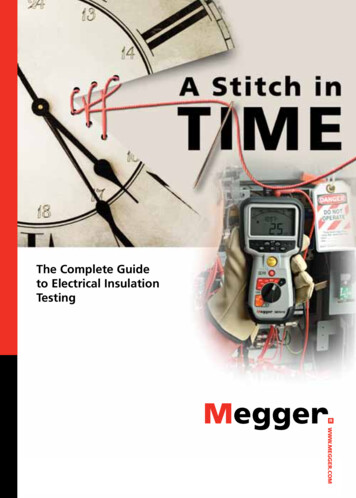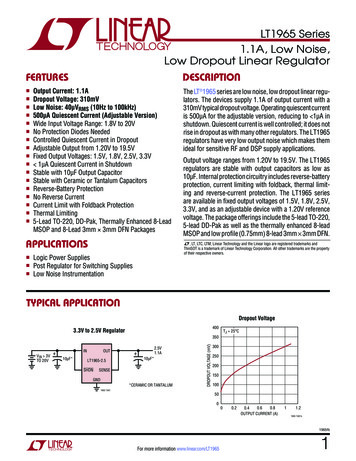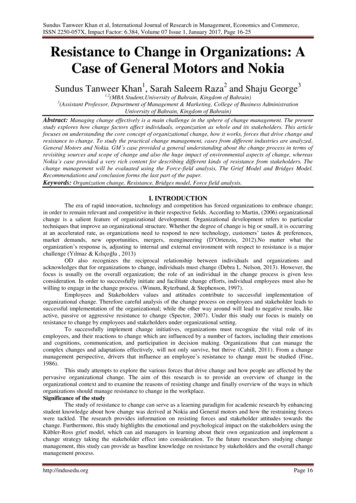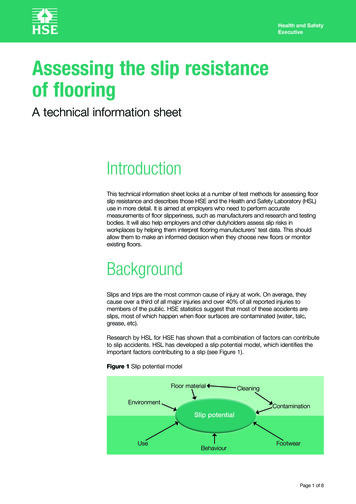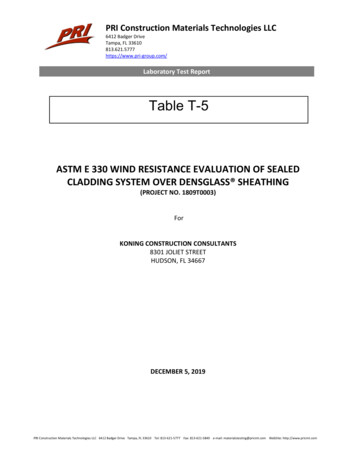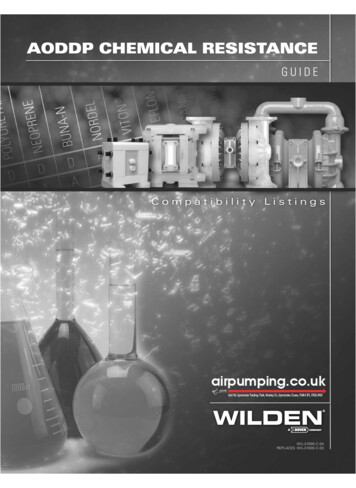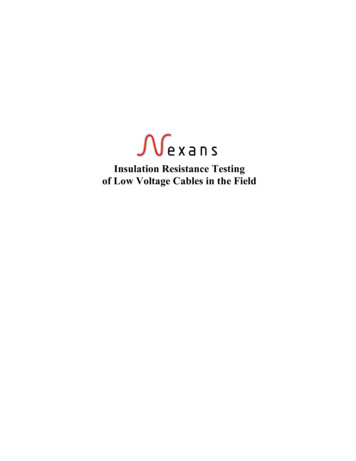
Transcription
Insulation Resistance Testingof Low Voltage Cables in the Field
25 June 2010Table of Contents1. Background.31.1. Before Making Measurements.31.2. How to Apply the Temperature Correction Factor .41.2.1. Calculation.41.2.2. Multiplication Factor Lookup.41.3. “Go / No Go” Minimum Acceptable Insulation Resistance Value.52. Installation Testing .52.1. Procedure .63. Preventative Maintenance Testing.63.1. Procedure .74. Summary.7Appendix A: Insulation Resistance Temperature Correction Factors.10Notes.11ReferencesCSA C22.2 No. 2556 / UL 2556, “Wire and Cable Test Methods”IEEE 525, “Guide for the Design and Installation of Cable Systems in Substations”NETA ATS-2009, “Standard for Acceptance Testing Specifications for Electrical Power Equipment and Systems”Warning:Insulation resistance testing should be done by qualified personnel, familiar with bothinsulation resistance testing and with the safe operation of the test equipment. Consultthe insulation resistance test equipment manual or manufacturer for insulationresistance testing procedures and recommended safety guidelines. This document isintended to be a guideline only.Page 2 of 12
25 June 20101. BackgroundThe following is a summary of insulation resistance (IR) testing (commonly referred to as “megger testing”) of lowvoltage cables (rated less than 5 kV), recognized by Nexans. This document will focus only on the tests that are ofimportance for field installers which are described as “Installation” and “Maintenance” tests. Testing should be doneby qualified personnel, familiar with both insulation resistance testing and with the safe operation of the testequipment. Nexans cannot provide actual insulation resistance values since they depend on a number of factors,such as: Insulation material; Conductor size; Conductor insulation temperature (i.e. if directly exposed to sunlight); Humidity (i.e. if the cable is wet); Cable length; and Cable end condition (i.e. insulation not stripped back, cable ends not separated).There are 4 types of insulation resistance tests for wire and cable that are recognized by Nexans:1. Type test / qualification test / conformance test;2. Factory test;3. Installation test; and4. Maintenance test.Type testing (also referred to as qualification testing or conformance testing) is typically performed on a new ormodified cable design, usually for the purpose of proving conformance to either CSA or UL standards. This type oftest is not performed on production runs of cable.Factory insulation resistance testing is performed when required at the factory of manufacture to ensureconformance to applicable standards / specifications. This test is performed according to a designated test method(e.g. as defined by CSA or UL).Installation tests are performed directly after cable installation, and before termination to any equipment oraccessories. Installation insulation resistance tests are only to be performed on new wire and cable. This type of testis a “go / no go” type of test, and is to determine if the insulation has been damaged during installation.Maintenance insulation resistance testing can be performed on a regular basis, and the collected data used to indicateif the conductor insulation is deteriorating over time. This type of test is a form of preventative maintenance. If theinsulation resistance falls below an accepted (user dictated) value, or falling rapidly over time, then cablereplacement is considered.Although 4 tests are listed above, this document will focus only on the tests that are of importance for field installerswhich are described as “Installation” and “Maintenance” tests.1.1. Before Making MeasurementsInsulation resistance test results are dependant on a number of factors, such as temperature and humidity. For thisreason, care must be taken to properly prepare the cable to be tested. For best results:1.Remove the cable from service, disconnecting all other circuits or devices, as well as any cable accessories andprotective end caps, and open the cable at both ends and ensure conductors are isolated from each other;2.Only test a cable if the temperature of the conductor is above the dew point – otherwise, moisture will form onthe surface of the insulation, and could be absorbed by the cable causing the test to fail;3.Make sure that the conductor surface is free of carbon, or any other material that may be conductive;4.Do not exceed the recommended test voltage of the cable – otherwise, the conductor insulation can beoverstressed, or even damaged; andPage 3 of 12
25 June 20105.Measure the temperature of the conductor insulation before each set of insulation resistance measurements –otherwise, the measured insulation resistance may seem abnormally high or low.1.2. How to Apply the Temperature Correction FactorIt is important to note that the insulation temperature may be significantly higher or lower than the ambient airtemperature. When the insulation temperature and the insulation resistance at that temperature are known, theinsulation resistance for any other temperature can be calculated. As an alternative, the insulation resistancetemperature correction factor can be looked up from a table, for a given standard temperature (15 ºC, as determinedby CSA and UL).1.2.1. CalculationThe insulation resistance can be calculated using the following formula:RS tan dard ReMeasured(TS tan dard TMeasured ) ln K Where:RMeasured is the measured insulation resistance, typically in mega-ohms or giga-ohms; RS tan dard is the insulation resistance at the desired temperature, in the same units as the measured insulation resistance;TMeasured is the measured insulation temperature, in degrees Celsius; TS tan dard is the desired insulation temperature, in degrees Celsius; andK is the coefficient of the insulation material.For example, we can calculate the insulation resistance at a desired insulation temperature, given the followingdetails:K 1.16TMeasured 50 ºCRMeasured 2.7 MΩTS tan dard 15 ºCUsing the formula above, the insulation resistance at this desired temperature (15 ºC) would be: 487 MΩ.1.2.2. Multiplication Factor LookupAlternatively, the insulation resistance can be determined by looking up the insulation resistance correction factorfrom a table of values (listed in Appendix A of this document). In this case, a standard temperature of 15 ºC hasbeen selected. The insulation resistance correction factor is applied using the following formula:RS tan dard RMeasured FWhere:RMeasured is the measured insulation resistance, typically in mega-ohms or giga-ohms; RS tan dard is the insulation resistance at the standard temperature (15 ºC), in the same units as the measuredinsulation resistance;Page 4 of 12
25 June 2010 F is the insulation resistance temperature correction factor from the table in Appendix A.For example, we can determine the insulation resistance at the standard temperature of 15 ºC, given the followingdetails:K 1.16TMeasured 50 ºCRMeasured 2.7 MΩFrom the table in Appendix A, we find that the insulation resistance temperature correction factor ( F ), for theinsulation material with a coefficient of 1.16 is: 180.31. Applying this factor, we calculate the insulation resistanceat the standard temperature (15 ºC) to be: 487 MΩ.1.3. “Go / No Go” Minimum Acceptable Insulation Resistance Value“Go / no go” testing is performed on new cable installations to determine if the insulation has been damaged duringinstallation. The minimum acceptable insulation resistance value is calculated using the following formula: 304.8 RInsulation (VRated 1) L Where:RInsulation is the minimum acceptable insulation resistance value, in mega-ohms;VRated is the rated voltage of the cable (typically printed on the cable), in kilovolts; andL is the length of the cable, in meters (if the cable length is in feet, replace the number 304.8 with 1000).For cables rated 600 V, the minimum acceptable insulation resistance values for cable lengths from 100 to 1000 feetwould be as shown in the following table, from IEEE 525.Table 1: Minimum Acceptable Insulation Resistance for 600 V Cable, from 100 to 1000 FeetMinimum Acceptable InsulationLength of CableResistance . Installation TestingAn insulation resistance test is typically performed on de-energized wire and cable immediately after installation,and before termination to any equipment or accessories. This test is used to detect conductor insulation damage thatmay have been caused during installation. This type of test is commonly referred to as “go / no go testing” (ordielectric withstand test), since the cable passes the test if no break-down occurs.Page 5 of 12
25 June 2010The test voltage selected for this type of test is less than 5 kV, and is applied for up to one minute, or until themeasured insulation resistance value stabilizes. The test voltage is the rated voltage of the cable (the line-to-linevoltage). Any voltage larger than this may stress the cable and cause premature failure.2.1. ProcedureFor each cable that is to be tested:1.Record the following data from the reel or coil tag: Reel / coil number; Date of manufacture; Cable length; Type of cable; and Conductor size.2.OPTIONAL – Measure and record the conductor insulation temperature. For a cable with multiple conductors,the insulation temperature for one of the conductors will suffice. This temperature may be different than theambient air temperature, especially if the cable is exposed to direct sunlight.3.Strip back the cable at each end, as if it were to be connected to the supply and load equipment (remove thejacket, separate the conductors, and strip the ends of the conductors of any insulation). The cable must bedisconnected from any equipment at both ends. This includes switches, receptacles, and any other kind ofdevice that may be connected to the conductors. An open switch connected to the cable could present a lowresistance path, making the cable appear to fail.4.Separate the conductors from each other, and from any ground conductors, to allow for the best possibleinsulation resistance reading.5.Thoroughly clean the exposed conductor ends to remove any dirt or debris. They should also be completely dryat the time of measurement. This will also improve the measurement.6.Conduct the insulation resistance test according to test set manufacturers instructions. We suggest applyingvoltage between each pair of insulated conductors, and insulated conductors to bare grounds, shields andarmour. All of the bare ground conductors are to be bonded together, and to any shields and / or armour thatmay exist in the cable, and grounded. Each insulated conductor should be tested separately and the resultsrecorded. For a 3-phase cable, containing 3 insulated conductors (A, B, and C), cabled with a bare ground (G),the suggested tests would be from: A to B; B to C; C to A; A to G; B to G; and C to G.7.Review the recorded measurements. Ultimately, this is a “go / no go” type of test, meaning that all insulationresistance measurement values must be greater than the “go / no go” acceptance value calculated, as shown inSection 1.3, above. Values that show an extremely large value (i.e. peak meter value) would indicate that therewas a possible connection issue in the system. Values that are at or near zero (0) would indicate that either theinsulation has failed somewhere along the length of the cable, or the cable to be tested was poorly prepared (i.e.equipment still connected to the cable, insulation not stripped back, cable ends not separated). If there is anyissue with interpreting the results, please consult Nexans for assistance.3. Preventative Maintenance TestingPreventative maintenance testing is typically performed on a cable that has already been in service for an extendedperiod of time (many months or years). This test is used to monitor any degradation in insulation performance overPage 6 of 12
25 June 2010time. Accurate records of the date of test, insulation resistance, as well as conductor insulation temperature must bekept. This data may be used to determine insulation deterioration.The test voltage selected for this type of test is les
The test voltage selected for this type of test is less than 5 kV, and is applied for up to one minute, or until the measured insulation resistance value stabilizes. The test voltage is the rated voltage of the cable (the line-to-line voltage). Any voltage larger than this may stress the
